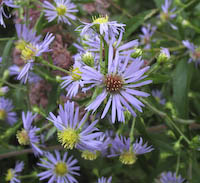 |
|
 |
 |
Purple-stemmed Aster
Symphyotrichum puniceum
(formerly Aster puniceus) |
 Other common names:
Glossy-leaved Aster, Swamp Aster Other common names:
Glossy-leaved Aster, Swamp Aster

Other scientific names:
Aster puniceus, Aster calvus, Aster compactus, Aster condupicatus, Aster demissus, Aster firmus, Aster lucidulus, Symphyotrichum firmum

French names:
Aster ponceau

Family:
Composite Family (Asteraceae)

Group:
Asters

Distinctive features:
Purple stem (but not always!). Grows in wet areas. Stem usually somewhat crooked (zig-zag). Relatively large sparse flowers, resembling those of New England Aster.

Similar species:
•
Rush Aster (Symphyotrichum boreale) - also grows in wet areas, but has very narrow, long leaves.
•
Smooth Aster (Symphyotrichum laeve) - may also have a purplish stem, but is smooth all over, including the leaves.
•
Bog Aster (Oclemena nemoralis) - also grows in wet areas, but usually has a single flower at the top of the stem.
•
New England Aster (Symphyotrichum novae-angliae) - also has numerous ray flowers, and clasping leaves, but grows in drier habitat.

Flowers:
Summer, Autumn; White, Blue/Violet; 7 or more parts (petals); 2.5cm in diameter. Ray flowers: numerous: 30-50, pale blue, mauve, violet, dark blue, or purple. Disc flowers: 30-90, yellow becoming purple.

Leaves:
Alternate, Simple, Entire; Gradually tapering to a base that clasps the stem, partially similar to those of New England Aster. Rough.

Height:
60-150 cm (23-59 in)

Stem:
Often reddish-purple (but not always). Usually bristly-hairy, but may be somewhat smooth. Fairly stout.

Habitat:
Fields and Open Areas, Wet Areas, Pond Margins, Marshes, Shrub Swamps, Moist Meadows; Swamps and open wet areas, wet thickets.

Grows in Sun/Shade:
Sun

Lifespan:
Perennial.

Books:
Newcomb's Wildflower Guide: 456
Peterson's Field Guide to Wildflowers: 356
ROM Field Guide to Wildflowers of Ontario: 191

Native/Non-native:
Native

Status:
Very common.

Notes:
This Aster grows in wet areas and has an open aspect to it. The stem is usually crooked, and the flowers resemble those of New England Aster. It is fairly common.

For more information visit:
Ontario Wildflowers

Photographs:
360 photographs available, of which 15 are featured on this page. SCROLL DOWN FOR PHOTOGRAPHS.

 |
 |
|
|
|
|
|
|
|  |
|